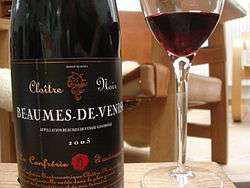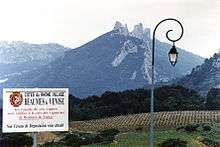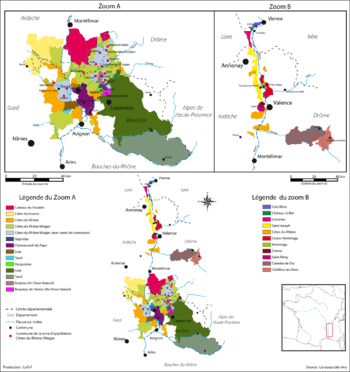Beaumes de Venise AOC
| Wine region | |
 | |
| Official name | Beaumes de Venise AOC |
|---|---|
| Type | Appellation d'origine contrôlé |
| Year established | Muscat 1943; cru 2005 |
| Years of wine industry | 2,000 |
| Country | France |
| Part of | Rhône Valley |
| Climate region | mediterranea |
| Soil conditions | north: sandy loam; south: argilo-calcerous |
| Size of planted vineyards | Muscat 503; cru: 541 |
| No. of vineyards | ca.100 |
| Wine produced | red; fortified |
| Official designation(s) | natural sweet wine (VDN) |
| Comments | ha: hectares, hl: hectolitres, hl/ha: hectolitres per hectare |
Beaumes de Venise is an appellation of wines from the eastern central region of the southern half of the Rhône Valley. It produces wines of two distinctly different types:
1. A sweet fortified wine of the type vin doux naturel (VDN), under the designation Muscat de Beaumes de Venise.[1]
2. A red Côtes du Rhône Villages from the classification of named villages, which typifies the quality wines of the Côtes du Rhône region.[1]
The vines are grown on the slopes around the foot of the Dentelles de Montmirail, a vertical comb of rock jutting out of the plain between the Rhône river and the Luberon-Ventoux mountains.[1] Beaumes is famed for its natural fortified wine made from the Muscat grape, and records of its use go back almost two millennia. More recently it is also the producer of a high quality red wine. In 1943 the natural Sweet Beaumes de Venise Muscat was accorded its appellation contrôlée, to be followed in 1956 by an AOC for its Côtes du Rhône. The red, white and rosé wines were elevated to the appellation of Côtes du Rhône Villages AOC (named villages) in 1978, and in 2005 the greatest honor of all was bestowed on the region when Beaumes de Venise rouge and the sweet fortified wine Muscat de Beaumes de Venise became a cru - the highest order of the wines in the Rhône Valley. Today, over 100 producers including fifteen domaines and a cooperative winery combine their efforts to maintain the highest standards and the centuries-old reputation of the town and its wines.[2]
Muscat de Beaumes de Venise AOC

Nearly two thousand years ago, Pliny the Elder wrote in his Natural History: "The Muscat grape has been grown for a long time in Beaumes and its wine is remarkable".[3]
In 1248, St. Louis took supplies of it with him on his 7th Crusade, and during the early 14th century, at the time of the reign of Pope Clement V, production was increased by 70 hectares to cater for the demand from the Popes' Palace in Avignon.
A unique feature of the way the grapes ripen is the way in which the warmth of the sun reflects and radiates down over the vines from the huge vertical limestone slabs of the Dentelles de Montmirail - the 'Lace of Montmirail'. Just under 500 hectares are currently under cultivation. The average yield is approximately 28 hectolitres per hectare.
The wine is produced from a single variety, the small berried Muscat which is also known as the Muscat de Frontignan, and must contain a minimum alcohol level of 15%. Mutage is carried out during the fermentation by the addition of 95° (minimum) proof spirit.[4][5]
Beaumes de Venise AOC
| Wikimedia Commons has media related to Beaumes de Venise (AOC). |
The vineyard is surrounded by the communes of Beaumes de Venise, Lafare, Suzette, and La Roque-Alric, all in the department of Vaucluse, and is situated on the southeastern flank of the Dentelles de Montmirail at an altitude of 100 to 600 metres. About 100 growers/producers are concerned with the average annual production of around 18,000 hectolitres for an average yield of 33 hectolitres per hectare and the grapes are manually harvested. Varieties that are blended to produce the red AOC are Grenache noir min. 50%, Syrah 25%, Mourvèdre and other varieties permitted by the appellation to a maximum of 20% with 5% of white grapes.[2]
The minimum degree of alcohol is fixed at 12.5%.[6]

References
- 1 2 3 INAO pdf government archive (French). Retrieved 15 September 2010
- 1 2 Rhône 'Committee for the Promotion of production, economy and marketing of Rhône Wine Retrieved 15 September 2010
- ↑ fr:Muscat de Beaumes-de-Venise (VDN)
- ↑ Le Conservatoire des A.O.C. de Beaumes-de-Venise (Le Cru Vin Doux Natural Muscat Beaumes-De-Venise) (French) Retrieved 16 September 2010
- ↑ Inter Rhône - Committee for the Promotion of production, economy and marketing of Rhône Wine - Vignobles de la Vallée du Rhône (Vignobles et Vins - Appelations CDR - Le Vin Du Natural - A.O.C. Muscat Beaumes de Venise - Beaumes de Venise) (French) Retrieved 16 September 2010
- ↑ Inter Rhône - Committee for the Promotion of production, economy and marketing of Rhône Wine - Vignobles de la Vallée du Rhône (Vignobles et Vins -Appelations CDR - Crus - Beaumes de Venise) (French) Retrieved 16 September 2010